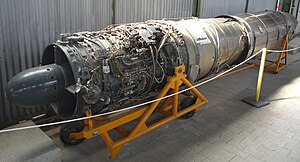SNECMA Atar 101C
| ATAR 101 | |
|---|---|
 |
|
| An ATAR 101G3 from a Super Mystère B2 on display. | |
| Type | Turbojet engine |
| National origin | France |
| Manufacturer | SNECMA |
| Designed by | Herman Östrich |
| First run | 26 March 1948 |
| Major applications | SNCASO S.O.4050 Vautour |
| Variants | SNECMA ATAR 8, SNECMA ATAR 9 |
The SNECMA ATAR 101 is a French axial-flow turbojet engine built by SNECMA. It was derived from engines and design work carried out at BMW in Germany during World War II, and extensively developed though a progression of more powerful models. The name is derived from its original design group, Atelier Technique Aéronautique de Rickenbach employing Herman Östrich and many of the wartime BMW gas turbine design group as well as other German engine design teams. The ATAR 101 powered many of the French post-war jet aircraft, including the Vautour II, Étendard IV, Super Mystère B2, and the Mirage III-001, prototype of the Mirage III series.
At the end of World War II the French aircraft industry was in disarray, having been commandeered by the German government to produce mostly German designed aircraft and aero-engines. To develop an indigenous gas turbine aero-engine the French government acquired the services of a large contingent of German design engineers and technicians. Some of these engineers formed the Atelier Technique Aéronautique de Rickenbach, led by Dr. Herman Östrich who had been developing gas turbine engines at BMW. By September the team were housed at the Dornier factory at Rickenbach near Lindau on Lake Constance and had largely completed design of the ATAR 101 by October 1945. A contract for development of the engine was awarded in December 1945, a stipulation being that all manufacturing was to be carried out in France.
Communications between the ATAR group and SNECMA, the newly formed Nationalised engine manufacturer, proved to be difficult and the design team soon moved to Decize on the River Loire, to improve communications with SNECMA and was renamed Aeroplanes G.Voisin, Groupe 'O' . Manufacture of components for the ATAR 101 V1 commenced at SNECMA plants in May 1946 and the first run was carried out on 26 March 1948.
...
Wikipedia
